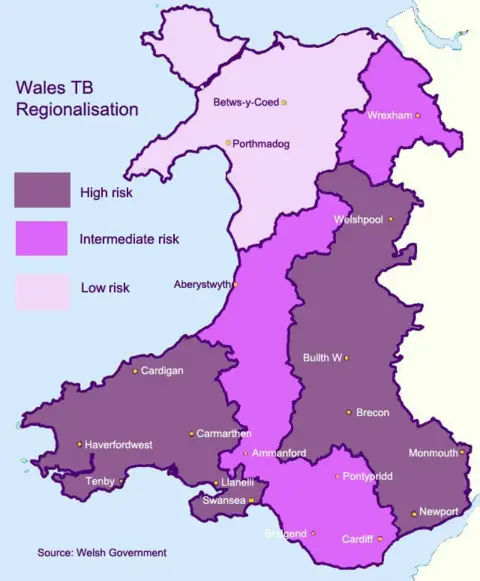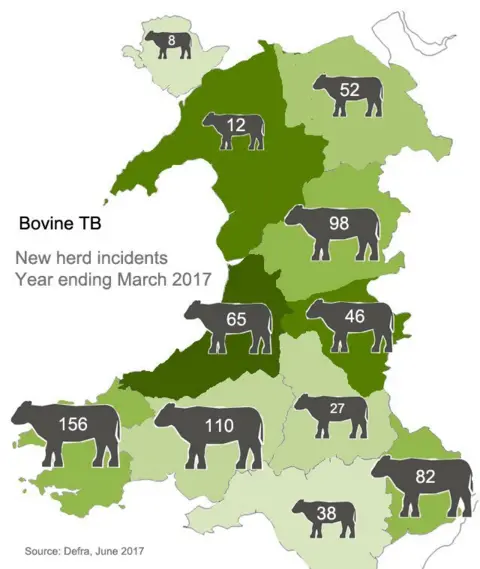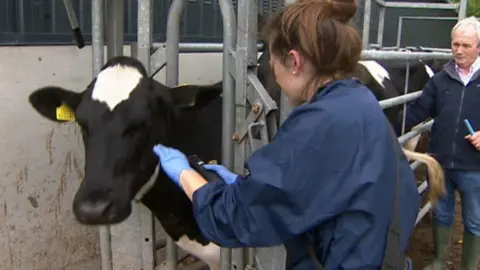Bovine TB risk map outlined in new Wales approach
Farms with chronic bovine TB problems will need individual action plans under tougher measures to tackle the disease.
Wales will be split from October into areas of low, intermediate and high risk, based on levels of TB.
Environment and Rural Affairs Secretary Lesley Griffiths has continued to rule out the large-scale culling of badgers that applies in England.
Humane killing of infected badgers near chronic TB cattle herds will be among options to stop the disease spreading.
The Welsh Government's measures were set out after a public consultation.



Farming unions said Wales' TB restrictions were already among the strictest in the world.
They urged measures to tackle the infection in badgers but a widespread cull has been resisted by Ms Griffiths.
Under the proposals:
- Farmers in high risk areas, such as Pembrokeshire, Carmarthenshire and along the border with England, would face tougher rules around moving and selling their cattle and more testing
- Farms with a long-term history of TB problems will be given individual action plans
- In these herds, where there is evidence of infection in the badger population, "a range of options" will look to reduce the risk of TB spreading, including cage-trapping, testing and Wwhere necessary, humanely killing infected badgers"
In 2015-16, the Welsh Government spent £26.4m on tackling the disease, which included money from the EU.
It is an expensive, complicated problem that has plagued several different governments and ministers as well as causing misery and financial ruin in rural Wales.
The number of cattle being slaughtered, particularly in west Wales, as a result of the disease has increased sharply in recent years, causing concern for farmers.
The Welsh Government insisted this rise is due to its efforts to drive out the disease for good.
Latest figures suggest bovine TB is at a 12-year low, with more than 95% of cattle herds in Wales currently free of the disease.

Ms Griffiths said "real progress" had been made towards eradicating it.
"I have listened to the industries responses to our consultation and have fed what was appropriate and reasonable into the programme," she said.
"This should not be seen as exclusively a government plan; it has been developed through consultation with industry and will be reviewed over time.
"I now call on the farming industry and veterinary profession to play a full part. Together we can achieve our goal of a TB-free Wales."
In May, the Welsh Assembly's Climate Change, Environment and Rural Affairs Committee called on ministers to set a national target date for the disease to be wiped out completely.
Farming leaders are worried ongoing issues with TB could affect future trade deals to export Welsh beef after Brexit.
Stephen James, NFU Cymru president, speaking before the announcement, said he wanted to see a "complete TB eradication programme that addresses not only the issues on farms but also in wildlife as well".
He added: "It's not fair that we as an industry keep getting more and more regulation and the wildlife part of it is overlooked."
Mr James said the Welsh Government had been "too slow to act" in parts of Wales where the disease was at its worse: "We've lost thousands of cattle as a result of it, and that's not fair on us."

Scientists have known for 40 years that badgers transmit TB to cattle and, more recently, probably vice versa.
Two years ago, a badger vaccination programme in north Pembrokeshire was put on hold following a global shortage of the TB jab.
There is no indication yet when or if that experiment will resume.
Wildlife groups remain resolutely opposed to any badger culling, while some scientists point out that latest research suggests it could make the problem worse.
